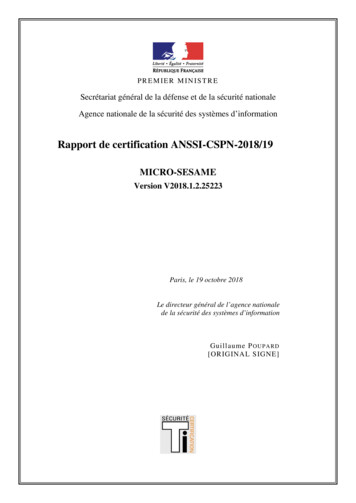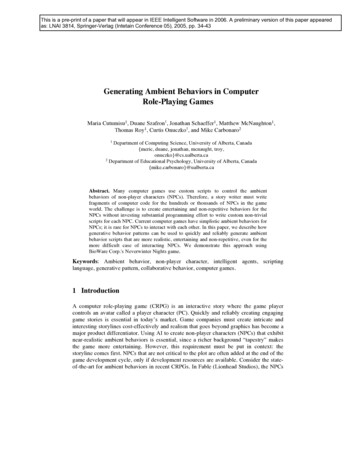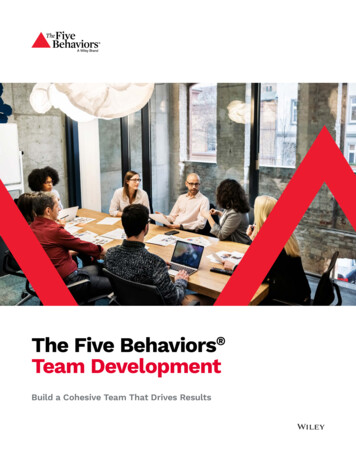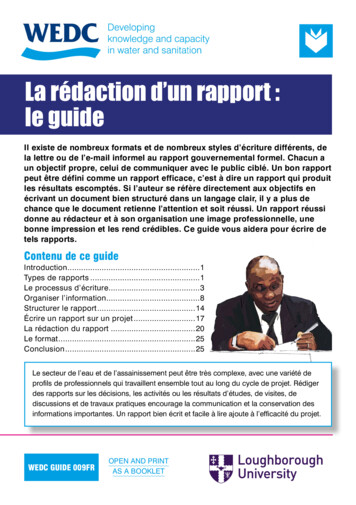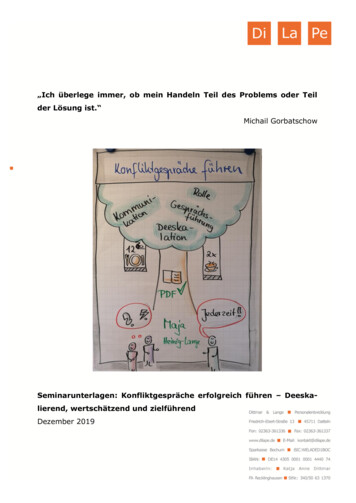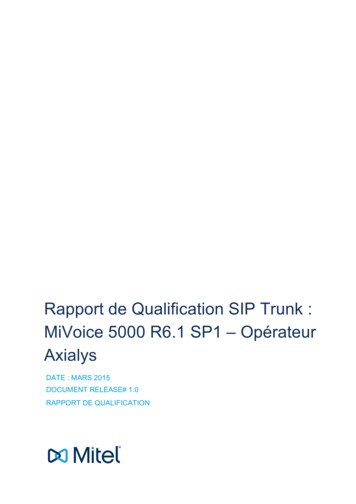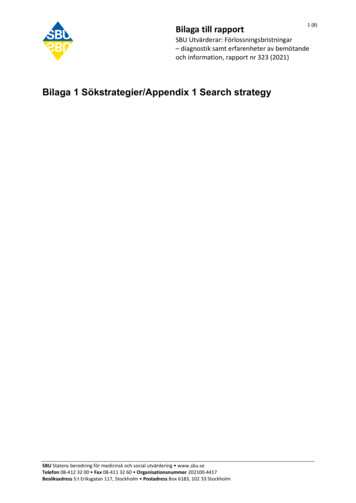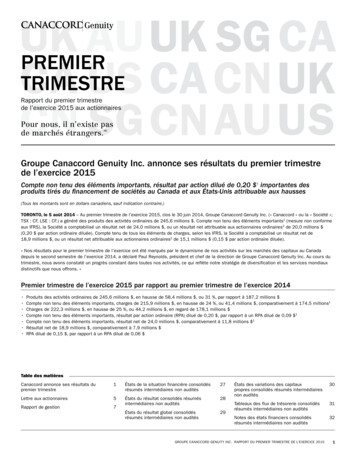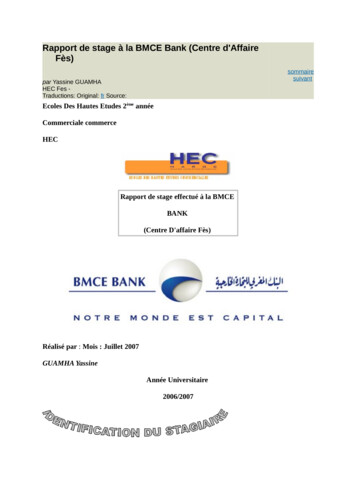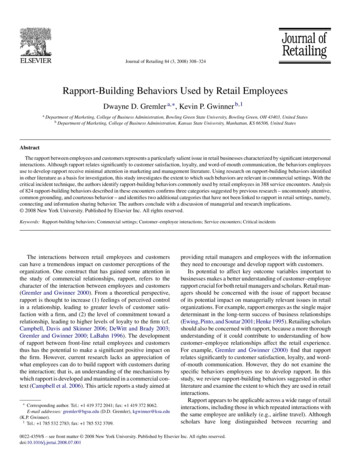
Transcription
Journal of Retailing 84 (3, 2008) 308–324Rapport-Building Behaviors Used by Retail EmployeesDwayne D. Gremler a, , Kevin P. Gwinner b,1aDepartment of Marketing, College of Business Administration, Bowling Green State University, Bowling Green, OH 43403, United Statesb Department of Marketing, College of Business Administration, Kansas State University, Manhattan, KS 66506, United StatesAbstractThe rapport between employees and customers represents a particularly salient issue in retail businesses characterized by significant interpersonalinteractions. Although rapport relates significantly to customer satisfaction, loyalty, and word-of-mouth communication, the behaviors employeesuse to develop rapport receive minimal attention in marketing and management literature. Using research on rapport-building behaviors identifiedin other literature as a basis for investigation, this study investigates the extent to which such behaviors are relevant in commercial settings. With thecritical incident technique, the authors identify rapport-building behaviors commonly used by retail employees in 388 service encounters. Analysisof 824 rapport-building behaviors described in these encounters confirms three categories suggested by previous research – uncommonly attentive,common grounding, and courteous behavior – and identifies two additional categories that have not been linked to rapport in retail settings, namely,connecting and information sharing behavior. The authors conclude with a discussion of managerial and research implications. 2008 New York University. Published by Elsevier Inc. All rights reserved.Keywords: Rapport-building behaviors; Commercial settings; Customer–employee interactions; Service encounters; Critical incidentsThe interactions between retail employees and customerscan have a tremendous impact on customer perceptions of theorganization. One construct that has gained some attention inthe study of commercial relationships, rapport, refers to thecharacter of the interaction between employees and customers(Gremler and Gwinner 2000). From a theoretical perspective,rapport is thought to increase (1) feelings of perceived controlin a relationship, leading to greater levels of customer satisfaction with a firm, and (2) the level of commitment toward arelationship, leading to higher levels of loyalty to the firm (cf.Campbell, Davis and Skinner 2006; DeWitt and Brady 2003;Gremler and Gwinner 2000; LaBahn 1996). The developmentof rapport between front-line retail employees and customersthus has the potential to make a significant positive impact onthe firm. However, current research lacks an appreciation ofwhat employees can do to build rapport with customers duringthe interaction; that is, an understanding of the mechanisms bywhich rapport is developed and maintained in a commercial context (Campbell et al. 2006). This article reports a study aimed at Corresponding author. Tel.: 1 419 372 2041; fax: 1 419 372 8062.E-mail addresses: gremler@bgsu.edu (D.D. Gremler), kgwinner@ksu.edu(K.P. Gwinner).1 Tel.: 1 785 532 2783; fax: 1 785 532 3709.providing retail managers and employees with the informationthey need to encourage and develop rapport with customers.Its potential to affect key outcome variables important tobusinesses makes a better understanding of customer–employeerapport crucial for both retail managers and scholars. Retail managers should be concerned with the issue of rapport becauseof its potential impact on managerially relevant issues in retailorganizations. For example, rapport emerges as the single majordeterminant in the long-term success of business relationships(Ewing, Pinto, and Soutar 2001; Henke 1995). Retailing scholarsshould also be concerned with rapport, because a more thoroughunderstanding of it could contribute to understanding of howcustomer–employee relationships affect the retail experience.For example, Gremler and Gwinner (2000) find that rapportrelates significantly to customer satisfaction, loyalty, and wordof-mouth communication. However, they do not examine thespecific behaviors employees use to develop rapport. In thisstudy, we review rapport-building behaviors suggested in otherliterature and examine the extent to which they are used in retailinteractions.Rapport appears to be applicable across a wide range of retailinteractions, including those in which repeated interactions withthe same employee are unlikely (e.g., airline travel). Althoughscholars have long distinguished between recurring and0022-4359/ – see front matter 2008 New York University. Published by Elsevier Inc. All rights reserved.doi:10.1016/j.jretai.2008.07.001
D.D. Gremler, K.P. Gwinner / Journal of Retailing 84 (3, 2008) 308–324nonrecurring retail interactions (Bitner and Hubbert1994; Rust and Oliver 1994), most research focusing oncustomer–employee interactions refers to repeated interactions(cf. Goodwin and Gremler 1996; Gwinner, Gremler, and Bitner1998; Reynolds and Beatty 1999). Because rapport applies tomany retail situations, and therefore is useful in both recurringand nonrecurring retail encounters, it provides a versatile andimportant construct for retailers (cf. DeWitt and Brady 2003;Gremler and Gwinner 2000).This research attempts to identify the specific rapportbuilding behaviors often present in retail interactions.Specifically, we conduct a study to investigate the followingquestion: Are the same rapport-building behaviors that markinterpersonal interactions also used by retail employees in service encounters? Toward this end, we first review relevantrapport research published primarily in the social psychologyliterature. Next, we discuss the results of a study designed toidentify rapport behaviors used in retail service encounters.Finally, we discuss the managerial and research implicationsderived from our findings.Rapport conceptualization and behaviorsThe construct of rapport has been the subject of studies in avariety of contexts and conceptualized in many different, thoughrelated, ways. For example, in a supervisor–subordinate context, rapport refers to “communication characterized by warmth,enthusiasm, and interest” (Heintzman et al. 1993, p. 200). In thearea of conflict mediation, rapport building entails the effortsused to create “more harmonious interaction between the parties” (Ross and Wieland 1996, p. 229). In the context of therelationship between a caregiver and a person with developmental disabilities, rapport is discussed in terms of the “quality of therelationship between two people” (McLaughlin and Carr 2005,p. 69). Finally, in the linguistics field, Spencer-Oatey (2002)conceptualizes rapport as social interactions with a particularlynoticeable impact on a relationship with another person. We citethese four studies not to suggest that one conceptualization ofrapport is correct and another is incorrect but rather to illustratethe varied and context-specific nature of the construct.Altman (1990) acknowledges the socially contextual natureof rapport and suggests that what constitutes and influences thedevelopment of rapport depends at least partially on the peopleinvolved and the context in which they interact. Altman alsocontends that in addition to these social influences, the physicalenvironment (e.g., public vs. private settings) that embeds therelationship influences the rapport process. Therefore, given theimpact of the social context and the environmental setting on thenature of rapport, we examine rapport in commercial (retail) contexts. Examining how rapport-building behaviors employed inother contexts, such as personal relationships or doctor–patientinteractions, may function in retail contexts provides the maincontribution of this research.To study rapport in a retail context, we define customer–employee rapport as the perceived quality of the relationship,dealing with the communication between the two parties andcharacterized by a connection or understanding among the par-309ticipants. The rapport-building behaviors discussed in the nextsection and those identified in the empirical study are notdimensions of rapport but instead represent employee behaviorsenacted to increase a customer’s rapport perceptions. On thebasis of an extensive review of rapport across various contexts –ranging from education to roommates to therapists to personalselling – and a series of in-depth interviews with both consumersand service providers, Gremler and Gwinner (2000) examinetwo dimensions of rapport in commercial service encounters:(1) enjoyable interactions involving (2) personal connectionsbetween the participants. This “commercial rapport” conceptualization is consistent with the view of rapport in other contexts.For example, in their often-cited article on the nature of rapport,Tickle-Degnen and Rosenthal (1990) describe three components that characterize relationships with a high level of rapport.Their “mutual attentiveness” and “positivity” components suggest rapport is higher in interactions in which the participants areinterested in each other and share a feeling of caring or friendliness. These two elements also appear in Gremler and Gwinner’soperationalization of the enjoyable interaction dimension of rapport. Tickle-Degnen and Rosenthal’s third element, coordination(participants are “in sync”), is reflected in Gremler and Gwinner’s personal connection dimension of rapport.Gremler and Gwinner’s (2000) study suggests that rapporthas a positive relationship with customer perceptions of satisfaction, loyalty, and positive word-of-mouth communication ina retail bank context. Likewise, we view a customer’s rapportperceptions as antecedents of service quality. Recent servicequality conceptualizations have brought increased attention tointeraction quality as an element of a higher-order service qualityconstruct (Brady and Cronin 2001). We suggest that enjoyable interactions that establish a personal connection positivelyinfluence Brady and Cronin’s interaction quality factor and, subsequently, service quality. Just as Altman (1990) argues thatresearchers should account for the contextual impact (e.g., commercial setting) when evaluating rapport, others suggest the needto consider context when evaluating service quality (Brady andCronin 2001). Dabholkar, Thorpe, and Rentz (1996) offer acontext-specific hierarchical model of retail store service quality which – similar to Brady and Cronin’s work – highlightspersonal interaction as a factor of service quality. Their personal interaction dimension combines employee behaviors thatinspire confidence and are courteous. Although the personal connection dimension of rapport is similar to the service qualityconstructs proposed by Brady and Cronin (2001) and Dabholkaret al. (1996), the notion of a personal connection between participants makes the rapport construct unique and different fromthe proposed subdimensions of service quality.A variety of strategies or techniques for building rapportappear in social psychology and communication literature(Andersen and Guerrero 1998; Bernieri et al. 1996; Fordand Etienne 1994; Lakin and Chartrand 2003; Thompson1998; Tickle-Degnen and Rosenthal 1987; Tickle-Degnen andRosenthal 1990), yet few studies examine whether the samerapport-building behaviors are used and/or applicable in commercial settings (cf. Bendapudi and Leone 2002; DeWitt andBrady 2003; Gremler and Gwinner 2000). We therefore review
310D.D. Gremler, K.P. Gwinner / Journal of Retailing 84 (3, 2008) 308–324the existing literature that has sought to identify behaviors viablefor rapport building.Rapport-building behaviorsOur review of the literature across several disciplines suggeststhat rapport-building behaviors can be classified broadly intofour groups: attentive behavior, imitative behavior, courteousbehavior, and common grounding behavior.Attentive behaviorSome researchers contend that simply being attentive to others can build rapport. Tickle-Degnen and Rosenthal (1987) arguethat rapport is highest when an encounter contains a high levelof mutual attentiveness between individuals. In this regard,Bernieri et al. (1996) identify three predictors of attentiveness:eye contact, physical proximity, and back-channel responses(e.g., head nods and “um-hmms”). Consistent with this notion,Grahe and Bernieri (1999) show that observers of dyadic interactions are more accurate in their rapport judgments when they canview the nonverbal aspects of the interaction. Attentive behavior also can be exhibited through motor mimicry – that is, whenone party displays communicative behavior that is appropriateto the situation or for the person with whom they are interacting(Andersen and Guerrero 1998). Finally, Hollman and Kleiner(1997) contend that rapport can be developed through emphaticlistening and attentiveness to how the other party is communicating. Such attentive behavior appears particularly relevant inretail encounters.Imitative behaviorRapport often is cultivated by imitating the behavior of theother party in an interaction. In general, this imitation involvesmatching the behaviors and/or voice patterns of the other person (Hunt and Price 2002; Thompson 1998; Tickle-Degnenand Rosenthal 1987; Tickle-Degnen and Rosenthal 1990). Suchmatching activities can take place on a variety of dimensions,including posture, voice tone, type of language, pace of speech,gestures, breathing patterns, or facial expressions. Furthermore,social psychology literature suggests that emotions displayed bytwo individuals often are matched through imitation, mimicry,and interpersonal facial feedback (cf. Andersen and Guerrero1998; Hatfield, Cacioppo, and Rapson 1994) and that mimicrycan increase rapport (Lakin and Chartrand 2003). In a salescontext, a neuro-linguistic programming approach calls forsalespeople to observe verbal and nonverbal customer cues andreact accordingly to develop higher levels of rapport (Nickels,Everett, and Klein 1983; Wood 2006). Such imitative behaviorsmight be useful in interactions with retail customers becausepeople tend to gravitate toward and become more comfortablearound those similar to themselves (Thompson 1998).Courteous behaviorOther scholars suggest courteous behavior is an effectivemethod for cultivating rapport (Ford and Etienne 1994; Hawes1994; LaBahn 1996; Sutton and Rafaeli 1988). For example,in a study of grocery cashiers, Ford (1995, p. 66) observes thatcourteousness helps a retailer “form a quick ‘bond’ with the customer and creates the necessary rapport for a positive serviceencounter.” In an organizational context, LaBahn (1996) findsa significant relationship between an advertising agency’s concern for the welfare of clients and clients’ rapport perceptions.Courteous behaviors often include simple actions that makeencounters enjoyable for the other person. For retail employees,these actions might entail smiling, using congenial greetings,engaging in polite behavior, showing concern for the customer’swelfare, remembering the customer’s name, or thanking the customer for his or her patronage (cf. Hunt and Price 2002).Common grounding behaviorIn personal selling literature, scholars suggest that peopleexperience “meaningful interactions” when they have similarbackgrounds, characteristics, tastes, and lifestyles (Churchill,Collins, and Strang 1975; Ewing et al. 2001). Common grounding occurs when one person attempts to discover areas ofsimilarity or mutual interest with the other (Goleman 1998).Office scanning, in which salespeople look around a prospect’soffice for common ground discussion topics (e.g., evidence ofmutual hobbies or similar interests), is one strategy salespeopleoften use to attempt to build common ground with customers(Weitz, Castleberry, and Tanner 2007). Employee behavior thatattempts to identify areas of similarity also seems applicablein a wide range of retail contexts, especially if employees andcustomers have an opportunity to engage in varying degrees ofconversation unrelated to the transaction (e.g., small talk).In summary, four broad categories of rapport-building behaviors emerge from previous research. Although these behaviorshave not been studied in retail encounters, they hold promise insuch settings.MethodThe critical incident techniqueThe critical incident technique (CIT), the method employedin this study, relies on a set of procedures to collect, content analyze, and classify observations of human behavior (Grove andFisk 1997). The CIT methodology offers a significant benefit,because it collects data from the respondent’s perspective and inhis or her own words (Gremler 2004). It therefore provides a richsource of data by allowing respondents to determine which incidents are the most relevant to them for the phenomenon beinginvestigated. In so doing, CIT allows respondents to include aswide a range of responses as possible within an overall researchframework (Gabbott and Hogg 1996). Furthermore, CIT appearsuseful in studying rapport-building behaviors in commercialcontexts, because it provides a means to gain knowledge aboutlittle known phenomena or when an in-depth understanding isdesired (Bitner, Booms, and Tetreault 1990; Gremler 2004).Data collection instrumentWe employ two CIT instruments: One form completed byretail customers and a second form completed by retail employ-
D.D. Gremler, K.P. Gwinner / Journal of Retailing 84 (3, 2008) 308–324ees. Participants responding in the role of the customer receivedthe following instructions:Think of a time when you had an experience with a service company or retailer where the employee attempted toestablish rapport with you. In particular, we are interested insituations where an employee specifically sought to create awarm, enjoyable interaction in an attempt to ‘connect’ withyou (the customer).Respondents provided information about the company, typeof service, location of the company, and when the incident tookplace. They then responded to a series of questions to assist theirrecall of the incident. Questions specifically prompted them todescribe the incident, recount what the employee specificallysaid or did in an attempt to establish rapport, disclose theirresponses to the actions of the employee, explain why this incident stood out, and report whether they continued to patronizethe organization after the incident.Employee respondents received similar instructions thatasked them to think of a time they attempted to establish rapportwith a customer and then describe that interaction in detail.Data collection proceduresWe collected the data in two waves. In Sample 1, 77 undergraduate students enrolled in an introductory marketing courseat a public university in the western United States participatedas data collectors as part of a class assignment. This technique has been used successfully in a variety of studies (e.g.,Bitner et al. 1990; Gwinner et al. 1998; Keaveney 1995), especially CIT research (Gremler 2004). Prior to data collection,students received training in the CIT method, including anoverview and examples of appropriate and inappropriate (e.g.,incomplete) responses. In addition, the training instructed students to terminate the interview and seek another respondentwhen a respondent was unable to think of a rapport-buildingincident.Gremler (2004) recommends that content analytic CIT studies should not use the same data set to develop and verifyclassification schemes. Therefore, we collected a second set ofdata to serve as the verification (confirmation) sample. Specifically, 64 undergraduate students enrolled in services marketingcourse at a public university in the Midwestern United Statesserved as data collectors for Sample 2. The procedures are identical to those used for Sample 1.22 In an attempt to encourage authentic responses, we undertook two mainactions. First, the instructions to the student data collectors included a warningthat the fabrication of an incident to complete the assignment would be considered cheating and those violating this requirement would have to deal withuniversity authorities. Second, the instructions indicated respondents would berandomly selected and contacted for a verification check (the survey included arequest for a first name and a daytime telephone number). A visual inspection ofthe questionnaires indicated sufficient variability in both handwriting and patterns across responses, as well as consistency within individual responses. Also,we randomly selected 35 respondents from Sample 1 and telephoned them todetermine if they had participated in the research; 30 indicated that they had, andthe remaining 5 could not be reached during three attempts. In those situations,311Classification sampleThe student interviewers collected 300 critical incidents forSample 1, of which 273 (91%) are suitable for use. The remaining 27 incidents (15 completed by customers, 12 by employees)are not appropriate as input for understanding employee attemptsat rapport building, according to the criteria listed in the codinginstructions in Appendix A.The critical incidents determined usable include stories toldby 133 customers (49% of the sample) and 140 employees.The sample is even in terms of gender, consisting of 137 menand 136 women. The customer respondents range in age from18 to 71 years, with an average age of 29.3 years (standarddeviation 11.6); the age range of employee respondents is18–53 years, with an average age of 26.1 years (standard deviation 8.0).Verification sampleIn Sample 2, the students collected 127 critical incidents, ofwhich 115 (91%) are suitable for use, according to the criteriain Appendix A. The usable incidents come from 59 customers(51% of the sample) and 56 employees. In this sample, 72respondents (63%) are women. The customer respondents inthe sample range in age from 20 to 65 years, with an averageage of 38.2 years (standard deviation 12.2); the age range ofemployee respondents is 20–73 years, with an average of 42.5years (standard deviation 12.8).Data analysisCategory developmentAs our review of rapport literature suggests, retail employeesmight use four broad categories of behaviors to build rapportin a commercial setting: attentive, common grounding, imitative, and courteous behavior. These four categories served asthe a priori starting point for developing our CIT classificationscheme.To construct a classification scheme of rapport-buildingbehaviors, two researchers – the lead author and another expertin the field (i.e., Judges A and B, respectively) – collected, read,reread, sorted, and resorted the critical incidents from Sample1. This effort revealed that many incidents include more thanone discrete rapport-building behavior. Consistent with priorresearch (Bendapudi and Leone 2002; Keaveney 1995), JudgesA and B determined that the discrete behaviors noted withineach critical incident, rather than the entire critical incidentstory, provide the most appropriate unit of analysis and bestpreserve the specificity of the data. The judges then discussedthe general themes that emerged, and Judge A developed a classification scheme with five broad categories of rapport-buildingbehaviors, fairly consistent with the a priori categories. JudgesA and B further analyzed and discussed the behaviors in eachcategory, which resulted in the development of more specificsubcategories of rapport-building behaviors (fourteen in all). Italso led to the creation of instructions that other judges couldwe contacted a different respondent from that data collector’s set to verify studyparticipation. Overall, we conclude that the data collected are authentic.
312D.D. Gremler, K.P. Gwinner / Journal of Retailing 84 (3, 2008) 308–324Table 1Classification results of rapport-building behaviorsRapport-building behavior categoryCustomer-described behaviorsEmployee-described behaviorsFrequencyFrequencyCategory 1: Uncommonly attentive behavior1A: atypical actions891B: personal recognition171C: intense personal interest25Category 1 totalCategory 2: Common grounding behavior2A: identifying mutual interests2B: finding other similaritiesCategory 2 totalCategory 3: Courteous behavior3A: unexpected honesty3B: civility3C: empathyCategory 3 totalCategory 4: Connecting behavior4A: using humor4B: pleasant conversation4C: friendly interactionCategory 4 totalCategory 5: Information sharing behavior5A: giving advice5B: imparting knowledge5C: asking questionsCategory 5 totalColumn total%%Row 9523.519223.3420100404100824100Notes: Because the classification sample (Sample 1) and verification sample (Sample 2) do not substantially differ, we combine the data into a single sample for easeof presentation and discussion. The percentages for customer- and employee-described behaviors represent the proportions of each respective subset of the data. TheRow Total percentages in the far right column represent the proportions of the entire data set.use to recognize the operational definitions of each categoryand subcategory of behaviors and thus classify rapport-buildingbehaviors in each incident. (See Appendix A for the codinginstructions and the operational definitions of each category.)In the next phase of analysis, a third judge, a doctoral marketing student (Judge C), read through all of the incidents, identifiedthe rapport-building behavior(s) in each, and coded each behavior using the classification scheme. A fourth judge, a graduatestudent with limited knowledge of the study (Judge D), independently read through all of the incidents and also coded thebehaviors in each incident. For those behaviors about whichJudges C and D did not agree, the first author (Judge A) resolvedany disagreements to determine a final categorization of eachbehavior. In total, the data from Sample 1 yield 273 usablecritical incidents containing 571 rapport-building behaviors.Category confirmationSample 2 serves as the verification sample to test the newlydeveloped classification scheme. We identified the rapportbuilding behaviors in Sample 2 incidents following the sameprocedure as used in Sample 1. The second sample yields 253rapport-building behaviors within 115 critical incidents. JudgesC and D again independently classified the behaviors containedin the Sample 2 critical incidents. No new categories emerged inthe process, which suggests that we collected a sufficient number of incidents for the CIT analysis (Flanagan 1954; Keaveney1995).Combining samplesBecause no new rapport-building behaviors emerge fromSample 2, we assess whether we can combine the data from thetwo samples. Specifically, a χ2 test indicates that the distributionof rapport-building behaviors does not differ significantly acrossthe two samples (χ2 .0053, p .10). In addition, we computeχ2 values for each individual rapport-building behavior and findthat only two of the fourteen values computed are statisticallysignificant at the .05 level. On the basis of the results of the overall χ2 test and the χ2 tests for the individual rapport-buildingbehaviors, we deem it appropriate to combine the data from thetwo samples for the purposes of presenting the results and con-
D.D. Gremler, K.P. Gwinner / Journal of Retailing 84 (3, 2008) 308–324ducting further analyses. Therefore, we base our study on 388critical incidents containing 824 rapport-building behaviors.ReliabilityTo assess the reliability of the classification scheme, we usetwo statistics: percentage of agreement and Perreault and Leigh’s(1989) Ir statistic. Across the 824 rapport-building behaviors,Judges C and D independently agree about the classificationof 680 behaviors for an overall agreement percentage of .825.Perreault and Leigh’s Ir value, which takes into account the number of categories included in the classification scheme, is .939across the two judges, well above the average of .85 typicallyreported in critical incident research (cf. Gremler 2004). Thesestatistics suggest a high level of reliability for our identification of rapport-building behaviors according to our classificationscheme.ResultsAn analysis of the incidents suggests the rapport-buildingbehaviors used by retail employees in interactions with customers are relatively consistent with the a priori behaviorsidentified in previous literature. Overall, we find that retailemployees use five broad categories of rapport-building behaviors in commercial contexts: uncommonly attentive behavior,common grounding behavior, courteous behavior, connectingbehavior, and information sharing behavior. Three of these fivecategories are consistent with existing rapport literature, whereastwo represent categories of behaviors not frequently mentionedin cultivating rapport. We provide a summary of the results inTable 1, which includes the five major categories of rapportbuilding behaviors as well as fourteen subcategories, the overallfrequency of each behavior, and the frequency of each behavior as reported by both customer and employee respondents.In addition, Table 2 contains representative paraphrases of theincidents, describing behaviors from each subcategory.Category 1: Uncommonly attentive behaviorRapport-building behaviors in this first category involveinstances in which the employee displays what could be considered particularly attentive behavior. Such behaviors oftenappear in situations in which the employee, as perceived by thecustomer, performs out-of-the-ordinary or above-and-beyondactions. Such attentiveness appears instrumental in the development of rapport between the employee and the customer andis consistent with one of the a priori set of behaviors, attentivebehavior. A total of 237 behaviors, or almost 29% overall, fallwithin this category.3 We l
Journal of Retailing 84 (3, 2008) 308-324 Rapport-Building Behaviors Used by Retail Employees Dwayne D. Gremlera, , Kevin P. Gwinnerb,1 a Department of Marketing, College of Business Administration, Bowling Green State University, Bowling Green, OH 43403, United States b Department of Marketing, College of Business Administration, Kansas State University, Manhattan, KS 66506, United States
